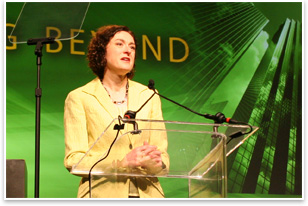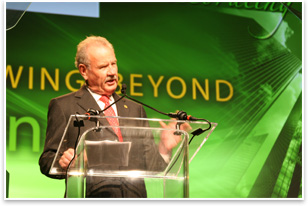
|
Green is the Word: AIA Kicks off National Convention
Summary: AIA Executive Vice President/CEO Chris McEntee and President RK Stewart, FAIA, welcomed a crowd of 2,700 to the kickoff session of the “greenest AIA convention ever” in San Antonio on May 3. The presence of 21 former AIA presidents served as a living reminder that—as the architects explore “Growing Beyond Green” and prepare for a sustainable future—they also are celebrating a rich history during this, the Institute’s 150th anniversary. San Antonio Mayor Phil Hardberger welcomed attendees to the seventh-largest U.S. city, and Stewart set the tone for the rest of the convention: “How we respond will not only speak to the sustainability of our profession, it will speak loudly to the sustainability of the planet itself.” David Suzuki, PhD, world leader in sustainable ecology, inspired professor, and author of 33 books, added a host of architects to his many devotees worldwide with his keynote speech on the dire global condition and his “Sustainability Within a Generation” plan to address the situation. [Read the story]
McEntee explained that part of the AIA strategic plan is ensuring that members have the tools they need to create the future they choose. “The payoff for your investment in coming to San Antonio is that you will leave with a clearer understanding and practical tips about what you can do tomorrow as a leader and an integral team member of the high-performance design approach,” she said. “The workshops, seminars, and special events that this convention’s program provides are key ingredients in having the AIA be the key resource for you and your practice.”
Among the steps to “green” the convention, Stewart counted contracting with all vendors, hoteliers, convention center staff, and other service providers to meet sustainable principles, as well as “paperless” education sessions. “We have reduced waste, maximized efficiency, and recycled at every opportunity,” he said. “San Antonio’s compact design should help reduce our carbon footprint, since many of us will be able to walk between venues or use public transportation.” Stewart also noted that each general session would be preceded with a video sketching 50 of the AIA’s 150 years to celebrate the Institute’s sesquicentennial. He noted also that “the AIA’s highest award for individual achievement, the Gold Medal, is also celebrating a milestone—its first 100 years.”
Living history in attendance
San Antonio is a 300-year-old city, but we are trying to change and are doing so, at the prompting of the local AIA chapter. Last week the city passed an ordinance that says that all new buildings will meet LEED® standards and be certified. Mayor Hardberger is among the signers of the U.S. Conference of Mayors proclamation on global warming. “We have had our citizens behind us in our water conservation efforts. We are now in the process of building our largest park in San Antonio,” he said. “I am confident that our citizens will rise to the challenge, and having the architects here will help us be recommitted to protecting our earth. “Thank you so much for being here. You are a source of inspiration,” Mayor Hardberger concluded. Major milestones “Here, in San Antonio, we will confront the challenge of sustainability and the challenge of going beyond single, tactical acts to a holistic strategy that acts on an understanding of how all the parts fit together. How we respond will not only speak to the sustainability of our profession, it will speak loudly to the sustainability of the planet itself.” |
||
Copyright 2007 The American Institute of Architects. All rights reserved. Home Page |
||
news headlines
practice
business
design
ArchiPAC Launches Major Push
“Having a fully funded PAC is essential to fulfilling our obligation to engage actively and effectively in civic discourse. It gives us access to the table where policies that will affect every aspect of our practice and our communities are discussed,” said AIA President RK Stewart. After all, in the end, architecture is public policy.”
ArchiPAC Chair, Mickey Jacob, AIA, told the group that last year, ArchiPAC raised $301,000 last year, more than had been raised in the past four years. And, as our momentum continues to grow, our convention goal is $60,000. Quoting Gandhi, Jacob urged conference attendees to “be the change you want to see in the world.” He noted that a receptive congress and a presidential election coming up create a great chance for the AIA. “We can effect change.,” Jacob concluded. “We just can’t do it without all of you.”

 “Welcome to San Antonio and the greenest AIA convention ever,”
said AIA Executive Vice President/CEO Chris McEntee as she kicked off the first session of the AIA national convention in San Antonio on May 3. “Our convention in San Antonio is a time to think in new and mind-expanding ways. What is our role as facilitators in the global debate on climate change? Will architects collaborate with like-minded individuals and organizations for the benefit of future generations? Or will we continue to live, work, and play in ways that threaten the lives of children and grandchildren?”
“Welcome to San Antonio and the greenest AIA convention ever,”
said AIA Executive Vice President/CEO Chris McEntee as she kicked off the first session of the AIA national convention in San Antonio on May 3. “Our convention in San Antonio is a time to think in new and mind-expanding ways. What is our role as facilitators in the global debate on climate change? Will architects collaborate with like-minded individuals and organizations for the benefit of future generations? Or will we continue to live, work, and play in ways that threaten the lives of children and grandchildren?” Advancing sustainability
Advancing sustainability
 San Antonio mayor welcomes architects
San Antonio mayor welcomes architects